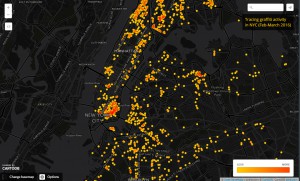Category Archives: Reflection
Seventh 100 Word Reflection: GIS and one GIS Graphic
(Pictured above is a GIS exercise I completed)
GIS has been and still is a very influential and liable tool from the time it was born in 1963, to today and probably will be the king of all tools for as long as humanity continues to reconstruct the space we live in and as long as we need a reliable source to pull out information on a region we are researching or working on. Over the years GIS and the purposes for GIS has transformed, but its transformations have been used to better serve the community as almost everyone uses GIS.
Reflections #7: GIS post & GIS as an aid for urban planners and designers
It was enthralling to learn both about the genesis of GIS and the concurrent application of GIS. Although we did not use GIS on Thursday, we learned the basics on how to use a similar system called CartoDB. Above is screenshot of a map I had made from the website, which aims to study the pattern of graffiti complaints in NYC for the past month.
Both GIS and Cartodb function from a database in which information can be extracted to formulate visual representations. Visual representation or aids can facilitate different methods of analysis, or learning which are highly applicable for research and planning methodologies. While the art of mapping has started in the 1700’s, GIS has enabled multidisciplinary fields to track information in gratifying ways since the 1980’s.
Information can be understood in a series of plots, shapes or colors that in the context of the map, creates a new form of investigation. New patterns are plotted on a map, which are endless: they can can either be topography of a place, which is helpful for landscape architects, for tracking traffic accidents, which is helpful for transportation planners, for studying income brackets in a neighborhood, which is helpful for urban planners, and even for studying crime, which is helpful for the police force. All these possibilities make me feel quite fortunate to have access to these tools, as there is an endless sea of open databases on the web.
Sixth 100 Word Reflection: Hypothesis about Vinegar Hill 1820-1870
My group and I arrived at many conclusions on Vinegar Hill from 1820-1870. We believe during that time, the Ferry Lines refocused the neighborhood, and when photography was introduced in 1839 that changed how every thing was documented and collected. We also believe that during that time, the government of Brooklyn were the wealthy land owners in Brooklyn , and they made sure the government was ran how they wanted it to be and everything favored them. And as far as documentation goes we think that population, jobs, money, buildings, were some of the collected things with the exception of the slave population.
Learning Places Library/Archive Report 2
I usually check up on my posts, and I just noticed that I mistakenly attached the wrong file for my second library/archive report. Please pardon my mistake. Please click on the link to view my second library/archive report:
CopyofLearningPlacesLibraryArchiveReport-2
Observation of Library/Archive
The time frame that my research is generally within is between the 1920s and 1960s. A number of my primary sources are maps and texts, such as the Brooklyn Daily Eagle newspaper archives; and many other secondary sources are also maps and text, such as articles found online. The Robert Moses website will provide many of the leads for locating governmental agencies involved in the city planning, finding documents and recorded information, and understanding political motives. The focus of my research is on Hudson Avenue, particularly the motive behind the urban renewal that caused it to be altered from the original construction. The context of my research is aimed at the point where Hudson Avenue intersects York Street. There were many major technological developments during the 1920s and 1960s, such as the radio and automobile. Aerial photography was used in surveying the landscape of Brooklyn. This timeframe also was just after World War I and enveloped World War II, which played a major role in the industry and urbanization of Brooklyn. The Navy Yard was utilized primarily for the wartime efforts. This also played a major role in the development of Vinegar Hill. Robert Moses and Mayor Laguardia, along with other influential agencies, played an important role in the development of Brooklyn and the relationships with nearby localities. There are many documents that can be retrieved from archives or online from governmental public records that can assist me with my research project. Knowing and understanding the contexts (primarily political and economic) for all of the urban development and renewal is a major aspect of truly capturing the accuracy of my research project.
Reflection #6: Hypothesizing Vinegar Hill 1870-1920
My group and I created hypotheses about Vinegar Hill during the 1870-1920. We focused predominantly on how technological developments impacted Vinegar Hill as a place. During the time period we were given, Brooklyn was becoming much more connected to the rest of New York City. The Brooklyn and Manhattan Bridge were completed in 1883 and 1909. These bridges directly attached Downtown Brooklyn to Manhattan. The construction of these bridges impacted Vinegar Hill in a few ways. One way Vinegar Hill was affected was many of it’s streets and buildings were demolished to make room for the Manhattan Bridge.
Bridges were not the only way Vinegar Hill was becoming more attached to the rest of the city. In the 1904 the first subway was opened. Shortly after 1904, many more subway routes were created providing thousands of people with easy and affordable transportation. In addition, cars were becoming more commonplace towards the 1920s. All of these factors made it easier for people to come and go from Vinegar Hill. Before the bridges, subways, and cars, people would not travel very far distances. Because of that there was a sense of dependency on the shops and industries in Vinegar Hill. That dependency faded away when people were given more ways to access Manhattan.
Hypotheses about Vinegar Hill 1820-1870, Reflection # 5
Me and my group was given time period of 1820 to 1870, in technological developmental part, we realized that still in vinegar hill houses reflect Italian styles brown stones, iron railings and boot scrapers. We found some signs of ferries paths which were leading to industries as well, some traces of gas lamp and form of electricity also found. Not only that we also found few transportation development in 1830 by civil and military engineer David Bates Douglas, who introduced traffic sic lanes, one for carts, one for light carriages and third one for pedestrians in two directions. For Civic & Private Organization part we found that the name today Brooklyn used to call “The Government Of Village Of The Brooklyn”. Secondly we found that information they used to capture in Brooklyn library, information like taxes, land record etc.
Reflections #6: Hypothesizing Vinegar Hill during the 1920’s-1960’s
In the 1920’s- 1960’s Technology stimulated infrastructural growth, as well as the growth of the manufacturing industry. Examples of infrastructural growth would pertain to the addition of the BQE, and the extension of the Brooklyn and Manhattan Bridge Extension Conditions. Growth of the manufacturing industry is also transparent through the use of the Navy Yard and through the structural methodology of steel and glass in architecture. Forms of technology that facilitated documentation during this growth period ranged from visual sources to verbal sources. Visual sources consist of photographs, varying from either aerial views or views at eye level as well as maps drawn from government agencies such as NYCHA or the Mayor’s Committee. Verbal sources consist of radio broadcasts and newspapers. Today, Vinegar Hill participates in the Brooklyn Tech Triangle, which is prevalent through it’s preservation of technologies and reinvention of construction and manufacturing methodologies i.e, CNC milling or 3D printing ship parts to design experimentation for facades etc.
Vinegar Hill has several entities contributing to it’s development, such as NYCHA, the Mayor’s Committee, Mayor LaGuardia and Robert Moses. Other agencies which participated in the growth of urbanism in Vinegar Hill would be the Department of Transportation, Department of Parks and the Brooklyn Navy Yard. Each of these entitites are drivers whom revitalized vinegar hill, by created new infrastructures, parks, housing complexes etc. Today, transportation has been made much more accessible through the addition of buses and trains, as well as projected bike paths. The power authority has also continued it’s presence through the utilization of the Con Edison properties.
Information that may have not been captured around this time period probably related to agricultural exports, imports or inventory as well as energy simulation through gas or electricity. We hypothesized that water and food quality were also not surveyed around this time.
Reading Reflections Homework
Reading: Rothman, Joshua. “Why is Academic Writing so Academic?”
People benefit from various forms of literature, but primarily specialists in an academic field of study are the ones who benefit most from academic literature. The wording used in academic literature is not intended for the ordinary/public audience so it may use jargon particular to the specific filed and void of layman understanding. The context may even be written in less rhetoric and provocative words that the layman may find boring and uninteresting. Academic writing is not usually meant to strike an emotional response or connection to the general public that the vast majority of written materials are known for. I agree with the article that the subject matter in academic writing is supposed to be directed towards the most serious of readers, professors. They are not interested in “sidebar” conversations, and they are only interested in pure facts and details, not rhetoric or connections. Their is little time for distractions (everyone is busy these days), and focus and concentration is necessary for pure scientific and unbiased interpretation of the data, the academic writing.
Reading: Annotated Bibliography
Is an annotated bibliography another for of academic writing? I strongly believe it is, because it is supposed to be concise and to the point. There is only a brief description and analysis of the referenced material (sources) and that means that there is no room for “fun and play” in your writing. Again, this writing is meant for your professor. No matter how funny and charismatic they may seem, if they are given something outside the norm of their expectations for a final paper (academic writing), you will lose points. Think – would you write jokes or a story about your research topic in your annotated bibliography?





